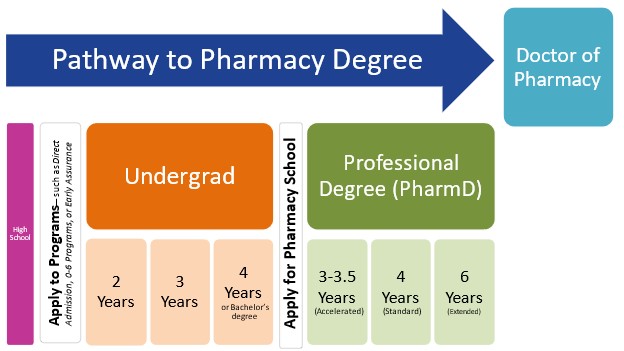Non-U.S. Students
Pharmacy Degree in the United States
The Doctor of Pharmacy (Pharm.D.) degree program in the United States requires at least 2-years of specific pre-professional (undergraduate) coursework followed by 4-academic years (or 3-calendar years) of professional study. The bachelor's (B.S.) of pharmacy degree is no longer offered in the U.S.
Pharmacy Admissions
The pharmacy admission process is competitive for all applicants. The classes required for admission vary by pharmacy school. The majority of U.S. pharmacy degree programs require all applicants to apply through the Pharmacy College Application Service (PharmCAS). Visit the PharmCAS Directory to determine whether a pharmacy school considers non-U.S. citizens for admission and to view admission requirements.and Pharmacy School Admission Requirements (PSAR) publication.
Admission Restrictions for Non-U.S. Applicants
Some U.S. pharmacy institutions do not consider international (non-U.S.) applicants for admission. International applicants may compete for a limited number of positions or may be ineligible for admission, depending on institutional and state policies. Private pharmacy institutions generally offer non-U.S. citizens a greater number of positions within the program as compared to state-supported, public institutions. Foreign citizens should visit the PharmCAS Directory or the website for each U.S. pharmacy school to determine if international (foreign) applicants are eligible for admission.
If the U.S. institution considers non-U.S. citizens for admission, the applicant must meet the same minimum entry requirements as American students, including course prerequisites and standardized tests. Applicants who completed pre-pharmacy study outside the U.S. will be required to submit original foreign transcripts or a course-by-course foreign transcript evaluation report, depending on school policy. Some pharmacy schools do not accept pre-pharmacy courses taken at a foreign institution and may require pre-pharmacy courses be completed in a U.S. accredited university.
TOEFL
If an applicant's primary language is not English, the pharmacy school may require the Test of English as a Foreign Language (TOEFL), Test of Spoken English (TSE), or another English language proficiency test as part of the admissions process. The TOEFL Study Guide is a helpful resource to assist foreign applicants to prepare. Additional information can be found on the PharmCAS Standardized Tests page.
Foreign Transcript Evaluation
World Education Services, Inc
P.O. Box 5087 Bowling Green Station
New York, NY 10274-5087
212-966-6311
info@wes.org
Non-U.S. Pharmacy Graduates
Pharmacy Practice in the U.S.
Foreign-trained pharmacists must complete one of two options before they can practice pharmacy in the U.S.
- Complete the FPGEC certification process: This pathway is only available to foreign-educated pharmacists who have previously completed the equivalent of a 5-year pharmacy degree program and earned an unrestricted license to practice pharmacy in their home country. Once foreign-educated pharmacists have successfully completed the FPGEC certification process, they are eligible to complete other U.S. state licensure requirements. Visit the National Association of Boards of Pharmacy (NABP) website to learn more about the FPGEC certification process.
- Graduate from an ACPE-accredited entry-level (traditional) Pharm.D. program: Foreign-educated pharmacists who are ineligible for the FPGEC certification process for any reason and wish to practice in the U.S. must complete the entire entry-level (traditional) Pharm.D. program at an ACPE-accredited institution, including all introductory (IPEE) and advanced pharmacy practice experience (APPE) requirements. Visit the PharmCAS School Directory to view all programs. Each program will determine whether a foreign-trained pharmacist is eligible for advanced standing status. If yes, only a limited number of didactic (classroom-based) courses in the entry-level Pharm.D. program may be waived. Graduates of Pharm.D. programs accredited by ACPE are eligible to take NAPLEX and complete other U.S. state licensure requirements.
Foreign-educated pharmacists who complete either option #1 or #2 may also need to complete additional U.S. immigration requirements before they are eligible work and live in the US.
Questions regarding FPGEC and licensure for graduates of foreign pharmacy programs should be directed to NABP.
Post-B.S. Pharm.D. Programs for Current Pharmacists Licensed in the U.S.
Pharmacists who previously earned a bachelor's degree in pharmacy in the United States (U.S.) or abroad may pursue a nontraditional post-baccalaureate (post-B.S./post-Bacc) Pharm.D. degree offered by colleges and schools of pharmacy accredited by the Accreditation Council for Pharmacy Education (ACPE). Nontraditional post-B.S. programs are ONLY available to pharmacists who currently hold a pharmacy license in the U.S. and have:
- Completed the Foreign Pharmacy Graduate Examination Committee (FPGEC®) certification process and other state licensure requirements, OR
- Graduated from an ACPE-accredited Bachelor of Pharmacy degree program before June 30, 2004.
Questions regarding FPGEC and licensure for graduates of foreign pharmacy programs should be directed to NABP.







